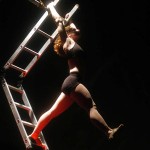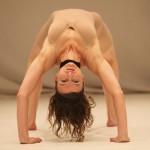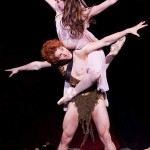2000 Feet’s 25 or so troupes from abroad, and a few American companies with foreign roots, speak in many languages, both verbal and body. Just reading about these dancers could add a bunch of new phrases to anyone’s vocabulary. Seeing them perform can teach the universal language of dance.
With 50 works to her credit, 35- year-old Chinese-American choreographer Li Chiao-Ping, of Li Chiao-Ping Dance, has established herself as one of the young forces majeurs of modern dance in the United States today. Her video/dance works, often made in collaboration with noted video artist Douglas Rosenberg, are shown at film festivals around the world. The programmers surely made a mistake in not scheduling her pieces as one of the festival’s main attractions. But their mistake is your gain. Fin de Siecle, I and II, will be shown twice: 2:30 p.m. Monday at a free lecture/demonsration at the Arts Bank, Broad and South Streets, and in a public performance late Thursday night.
(A brief digression about schedules: All public performances recommended here are listed on Page 26. Many other opportunities to see and hear about dance this week, including dozens of “lecture/demonstrations,” are mainly for conference registrants but are free and open to everyone, space permitting. A schedule of those is in the Festival Guide available at all events, and at the Inquirer’s site on the Internet: http://entertainment.philly.com/2000feet/)
Fin de Siecle is an amazing 22-minute dance. Li, a powerhouse dancer, is still recovering from an early-winter auto accident; her Part I solo will be danced by Walter Dundervill and Part II by the full company of four. Watching Fin de Siecle is a perfect way to learn what is meant by the term “postmodern dance.” Li’s costuming, for instance, is reminiscent of the Italian futurists and the Bauhaus – the things that started all this early in the century. The choreography moves robotically, athletically and even balletically through the styles of the century, yet all the while it is clearly influenced by Chinese dance training. The piece will represent the genre well into the next century.
Tuesday evening at the Drake, Dundervill performs Chi, Li’s signature dance. Before her accident, Li had been working on Satori (which the company premieres on the same Tuesday program), a piece to music by Japanese shakuhachi master Riley Lee. In it, she works on extreme uses of the body but shapes awkward movements into gracefulness. “Since I no longer could use my own body to investigate or demonstrate with, I relied on my visual sense to create this work – a different process for me,” she told me by phone from her home base in Madison, Wis.
Postmodern dance turns modern and classical dance inside out – rather like wearing a couturier ball gown with the inseams, boning, and zipper placket exposed so that you see its structure, how it was made. Practitioners often use technologies and text, anything that helps them pull together and make sense of the artistic forms and political events of our times. One of the beauties of these contemporary dance forms is their ability to enfold other cultures and traditions and reinterpret them.
The following companies are also steeped in these techniques and represent the way the genres are developing in their home countries. Their performances, like all the public performances in 2000 Feet, are parts of mixed bills with several other companies.
A not-to-be-missed performance will be Nai-Ni Chen Dance Company’s Dragons on the Wall, Wednesday evening at the Merriam. Featuring a live performance by the ethereal soprano Joan LaBarbara, who composed the music, Dragons is part of Chen’s ongoing series called “Calligraphy.
Chen, like Li, is Chinese American, having arrived from Taiwan in 1981 to study at New York University at the age of 22. She, too, works in postmodern idioms with some martial-arts influence, but even more clearly lets her early traditional Chinese dance training shine through. An exquisite dancer, she will perform in a longer version of Dragons at the lecture/demonstration at 2:30 p.m. Tuesday at the Arts Bank.
For Chen, dance is not just physical expression. It has visual elements, too. “Calligraphy is like painting,” she said by phone from her studio in Fort Lee, N.J. “Within it, you can find parallels to many artistic `isms’ – the lines get blurred today.”
France’s Companhia Ladainha blurs ethnic lines so much it is almost impossible to identify the soil from which their new “isms” spring. Laina Fischbeck – the daughter of German-born Manfred Fischbeck, who founded Group Motion here in 1968 – left for France more than a year ago and met up with a dancer from the Rennes-based company while studying in Normandy. After an audition, the company invited Fischbeck to join.
When pushed to name her top five picks, 2000 Feet codirector Susan Glazer included Ladainha: “They surely will be one of the big hits of the festival.” After seeing their preview at Kumquat last weekend, I agree. Brazilian Capoeira master and company cofounder Armando Pekeno delivers an adrenalin rush to movement junkies, and Fischbeck has never danced better. She trains six hours a day in Capoeira, an Angolan-style martial art disguised as dance, and Candomble, a danhe training has dispelled Fischbeck’s old South Street ennui and imbued her body with a mysterious new energy and intelligence. She and Michele Brown, the other cofounder of the French company, and three other beautiful dancers were tres formidable with their ataques and take-downs.
Like tai chi, the Capoeira disciplines that Pekeno and Brown base their choreography on can be forceful and sudden, but is rarely violent-looking. The most explosive movements are when the five women, lying on their backs, jerk their bodies upward, momentarily levitating a foot or so off the floor. The musicians who accompany them – and sometimes dance – in ORU: Heat, Vapor, Energy, make percussive musical dynamism that more than matches the title. They’ll perform on Tuesday afternoon, with a generous lecture/demonstration at 4 p.m. Thursday at the Arts Bank.
Australia’s Expressions, another highly physical troupe, created quite a buzz when they performed in the United Kingdom a couple of years ago. Here they bring extracts from Jigsaw, a later work. Company members are known for their hell-bent cleverness and hilarious takes on just about everything. By e-mail, they describe Jigsaw as “a hybrid of several disciplines, including ballet, that explores phobias.” They’ll perform Thursday evening at the Merriam, and give a lecture/demo at 10 a.m. next Friday at the Arts Bank.
Transitions is a London-based professional company that accepts only the top graduated dancers and gives them the opportunity to work with Europe’s award-winning choreographers. They’ll perform a 1999 work for four men and one woman that contrasts spiraling athleticism and still moments to music by Fred Frith. Another piece – to music by the Klezmatics – is a high-wired, high-velocity dance on the same Tuesday night program at the Merriam. A demonstration at 1 p.m. Thursday at the Arts Bank offers a chance to see the company’s hits from last year.
Transitions is a London-based professional company that accepts only the top graduated dancers and gives them the opportunity to work with Europe’s award-winning choreographers. They’ll perform a 1999 work for four men and one woman that contrasts spiraling athleticism and still moments to music by Fred Frith. Another piece – to music by the Klezmatics – is a high-wired, high-velocity dance on the same Tuesday night program at the Merriam. A demonstration at 1 p.m. Thursday at the Arts Bank offers a chance to see the company’s hits from last year.
Latin
Spain, Mexico and Venezuela are represented by large troupes at the festival. Of these, the Madrid natives who form Noche Flamenca, now based in New York, already have a slew of fans here. From their first Jaleo – the Andalucian term for the shouting and clapping that encourages the dancers to jest and make merry – to the setting of their last, lonely Solea, they’ll once again please their crowd. Noche Flamenca, which sold out the Wilma Theater for 10 days in January, is appearing at Saturday night’s opening gala as a prelude to a second run at the Wilma beginning Wednesday.
Even those who find bourrees (those teensy on-pointe steps) boring will be intrigued by Venezuela’s Ballet Metropolitano de Caracas. This is classical ballet infused with Latin zing. Wednesday evening at the Merriam, 10 of their dancers will perform a salute to Venezuelan dance, to music by Latin-American composers.
Mexico’s Delfos fuses Latin and western modern dance and is another of festival codirector Glazer’s picks. She says to watch for the delicately traced choreography, defined by impeccable body work. Sunday night’s program at the Merriam will offer an unusual opportunity to see a neighbor nation’s contemporary work.
In a burst of joyful brilliance, the programmers have engaged the Philadelphia-based Samba Nosso drum and dance group to lead the audience in and out of the Merriam at Saturday’s gala. Samba Nosso plays African-influenced styles of authentic Brazilian music with musicians and dancers from around the world.
Asia-Pacific
After watching anorexic Western ballerinas with their hinged elbows and knees, most Asian dancers appear boneless. Their limbs are breathtakingly fluid, with no awkward joints. Because of their rigorous training, it is unlikely that audiences will see even one mediocre dancer out of the eight contemporary troupes from China, Hong Kong, Korea, Kuala-Lumpur, Taiwan and Singapore.
When pressed for her favorites, Pearl Schaeffer, director of the Philadelphia Dance Alliance and Glazer’s partner in 2000 Feet, blurted out China’s Guangdong Modern Dance Company first. “I’m interested in seeing modern dance with roots in the U.S. being reinterpreted by a Chinese company,” she said. The members of Guangdong Modern Dance, founded by the Chinese government in 1992, “use elements of contact improvisation, they’re highly gestural, and use partnering well. Their costuming is very western – the men bare-breasted with baggy white pants and the women often have minimal costuming with long sleeves or fabric trailing behind.” The company will be on a Thursday night bill at the Merriam.
http://articles.philly.com/1999-06-18/entertainment/25500834_1_postmodern-dance-dance-works-classical-dance#.UB70tK5fnB4.email






